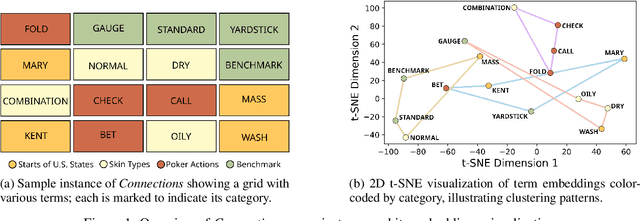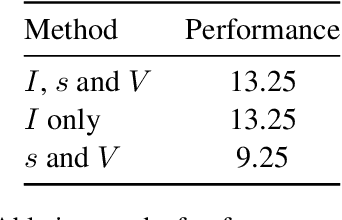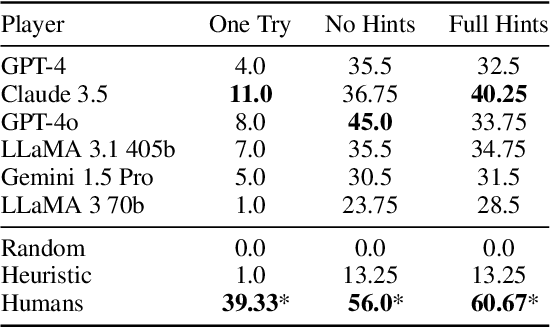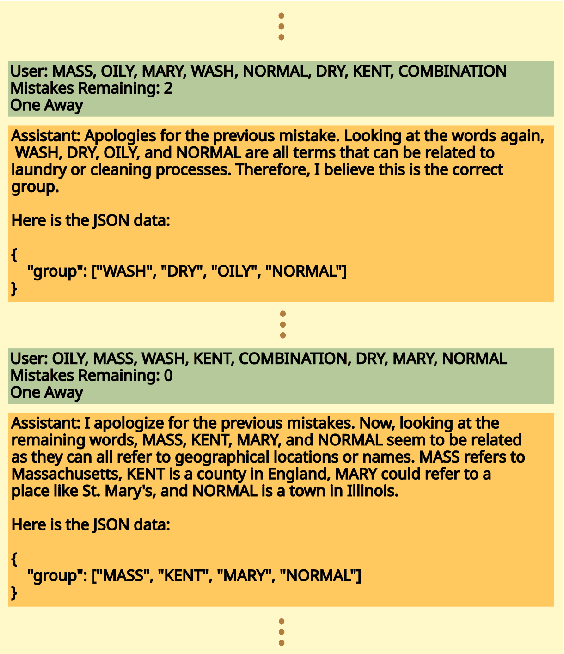Ali Emami
The Dog the Cat Chased Stumped the Model: Measuring When Language Models Abandon Structure for Shortcuts
Oct 23, 2025Abstract:When language models correctly parse "The cat that the dog chased meowed," are they analyzing syntax or simply familiar with dogs chasing cats? Despite extensive benchmarking, we lack methods to distinguish structural understanding from semantic pattern matching. We introduce CenterBench, a dataset of 9,720 comprehension questions on center-embedded sentences (like "The cat [that the dog chased] meowed") where relative clauses nest recursively, creating processing demands from simple to deeply nested structures. Each sentence has a syntactically identical but semantically implausible counterpart (e.g., mailmen prescribe medicine, doctors deliver mail) and six comprehension questions testing surface understanding, syntactic dependencies, and causal reasoning. Testing six models reveals that performance gaps between plausible and implausible sentences widen systematically with complexity, with models showing median gaps up to 26.8 percentage points, quantifying when they abandon structural analysis for semantic associations. Notably, semantic plausibility harms performance on questions about resulting actions, where following causal relationships matters more than semantic coherence. Reasoning models improve accuracy but their traces show semantic shortcuts, overthinking, and answer refusal. Unlike models whose plausibility advantage systematically widens with complexity, humans shows variable semantic effects. CenterBench provides the first framework to identify when models shift from structural analysis to pattern matching.
Personality Matters: User Traits Predict LLM Preferences in Multi-Turn Collaborative Tasks
Aug 29, 2025Abstract:As Large Language Models (LLMs) increasingly integrate into everyday workflows, where users shape outcomes through multi-turn collaboration, a critical question emerges: do users with different personality traits systematically prefer certain LLMs over others? We conducted a study with 32 participants evenly distributed across four Keirsey personality types, evaluating their interactions with GPT-4 and Claude 3.5 across four collaborative tasks: data analysis, creative writing, information retrieval, and writing assistance. Results revealed significant personality-driven preferences: Rationals strongly preferred GPT-4, particularly for goal-oriented tasks, while idealists favored Claude 3.5, especially for creative and analytical tasks. Other personality types showed task-dependent preferences. Sentiment analysis of qualitative feedback confirmed these patterns. Notably, aggregate helpfulness ratings were similar across models, showing how personality-based analysis reveals LLM differences that traditional evaluations miss.
The World According to LLMs: How Geographic Origin Influences LLMs' Entity Deduction Capabilities
Aug 07, 2025Abstract:Large Language Models (LLMs) have been extensively tuned to mitigate explicit biases, yet they often exhibit subtle implicit biases rooted in their pre-training data. Rather than directly probing LLMs with human-crafted questions that may trigger guardrails, we propose studying how models behave when they proactively ask questions themselves. The 20 Questions game, a multi-turn deduction task, serves as an ideal testbed for this purpose. We systematically evaluate geographic performance disparities in entity deduction using a new dataset, Geo20Q+, consisting of both notable people and culturally significant objects (e.g., foods, landmarks, animals) from diverse regions. We test popular LLMs across two gameplay configurations (canonical 20-question and unlimited turns) and in seven languages (English, Hindi, Mandarin, Japanese, French, Spanish, and Turkish). Our results reveal geographic disparities: LLMs are substantially more successful at deducing entities from the Global North than the Global South, and the Global West than the Global East. While Wikipedia pageviews and pre-training corpus frequency correlate mildly with performance, they fail to fully explain these disparities. Notably, the language in which the game is played has minimal impact on performance gaps. These findings demonstrate the value of creative, free-form evaluation frameworks for uncovering subtle biases in LLMs that remain hidden in standard prompting setups. By analyzing how models initiate and pursue reasoning goals over multiple turns, we find geographic and cultural disparities embedded in their reasoning processes. We release the dataset (Geo20Q+) and code at https://sites.google.com/view/llmbias20q/home.
Trace-of-Thought Prompting: Investigating Prompt-Based Knowledge Distillation Through Question Decomposition
Apr 30, 2025Abstract:Knowledge distillation allows smaller neural networks to emulate the performance of larger, teacher models with reduced computational demands. Traditional methods for Large Language Models (LLMs) often necessitate extensive fine-tuning, which limits their accessibility. To address this, we introduce Trace-of-Thought Prompting, a novel framework designed to distill critical reasoning capabilities from high-resource teacher models (over 8 billion parameters) to low-resource student models (up to 8 billion parameters). This approach leverages problem decomposition to enhance interpretability and facilitate human-in-the-loop interventions. Empirical evaluations on the GSM8K and MATH datasets show that student models achieve accuracy gains of up to 113% on GSM8K and 21% on MATH, with significant improvements particularly notable in smaller models like Llama 2 and Zephyr. Our results suggest a promising pathway for open-source, low-resource models to eventually serve both as both students and teachers, potentially reducing our reliance on high-resource, proprietary models.
TALE: A Tool-Augmented Framework for Reference-Free Evaluation of Large Language Models
Apr 10, 2025Abstract:As Large Language Models (LLMs) become increasingly integrated into real-world, autonomous applications, relying on static, pre-annotated references for evaluation poses significant challenges in cost, scalability, and completeness. We propose Tool-Augmented LLM Evaluation (TALE), a framework to assess LLM outputs without predetermined ground-truth answers. Unlike conventional metrics that compare to fixed references or depend solely on LLM-as-a-judge knowledge, TALE employs an agent with tool-access capabilities that actively retrieves and synthesizes external evidence. It iteratively generates web queries, collects information, summarizes findings, and refines subsequent searches through reflection. By shifting away from static references, TALE aligns with free-form question-answering tasks common in real-world scenarios. Experimental results on multiple free-form QA benchmarks show that TALE not only outperforms standard reference-based metrics for measuring response accuracy but also achieves substantial to near-perfect agreement with human evaluations. TALE enhances the reliability of LLM evaluations in real-world, dynamic scenarios without relying on static references.
Fine-Tuned LLMs are "Time Capsules" for Tracking Societal Bias Through Books
Feb 07, 2025Abstract:Books, while often rich in cultural insights, can also mirror societal biases of their eras - biases that Large Language Models (LLMs) may learn and perpetuate during training. We introduce a novel method to trace and quantify these biases using fine-tuned LLMs. We develop BookPAGE, a corpus comprising 593 fictional books across seven decades (1950-2019), to track bias evolution. By fine-tuning LLMs on books from each decade and using targeted prompts, we examine shifts in biases related to gender, sexual orientation, race, and religion. Our findings indicate that LLMs trained on decade-specific books manifest biases reflective of their times, with both gradual trends and notable shifts. For example, model responses showed a progressive increase in the portrayal of women in leadership roles (from 8% to 22%) from the 1950s to 2010s, with a significant uptick in the 1990s (from 4% to 12%), possibly aligning with third-wave feminism. Same-sex relationship references increased markedly from the 1980s to 2000s (from 0% to 10%), mirroring growing LGBTQ+ visibility. Concerningly, negative portrayals of Islam rose sharply in the 2000s (26% to 38%), likely reflecting post-9/11 sentiments. Importantly, we demonstrate that these biases stem mainly from the books' content and not the models' architecture or initial training. Our study offers a new perspective on societal bias trends by bridging AI, literary studies, and social science research.
Think or Step-by-Step? UnZIPping the Black Box in Zero-Shot Prompts
Feb 05, 2025Abstract:Zero-shot prompting techniques have significantly improved the performance of Large Language Models (LLMs). However, we lack a clear understanding of why zero-shot prompts are so effective. For example, in the prompt "Let's think step-by-step," is "think" or "step-by-step" more crucial to its success? Existing interpretability methods, such as gradient-based and attention-based approaches, are computationally intensive and restricted to open-source models. We introduce the ZIP score (Zero-shot Importance of Perturbation score), a versatile metric applicable to both open and closed-source models, based on systematic input word perturbations. Our experiments across four recent LLMs, seven widely-used prompts, and several tasks, reveal interesting patterns in word importance. For instance, while both 'step-by-step' and 'think' show high ZIP scores, which one is more influential depends on the model and task. We validate our method using controlled experiments and compare our results with human judgments, finding that proprietary models align more closely with human intuition regarding word significance. These findings enhance our understanding of LLM behavior and contribute to developing more effective zero-shot prompts and improved model analysis.
Can We Afford The Perfect Prompt? Balancing Cost and Accuracy with the Economical Prompting Index
Dec 02, 2024



Abstract:As prompt engineering research rapidly evolves, evaluations beyond accuracy are crucial for developing cost-effective techniques. We present the Economical Prompting Index (EPI), a novel metric that combines accuracy scores with token consumption, adjusted by a user-specified cost concern level to reflect different resource constraints. Our study examines 6 advanced prompting techniques, including Chain-of-Thought, Self-Consistency, and Tree of Thoughts, across 10 widely-used language models and 4 diverse datasets. We demonstrate that approaches such as Self-Consistency often provide statistically insignificant gains while becoming cost-prohibitive. For example, on high-performing models like Claude 3.5 Sonnet, the EPI of simpler techniques like Chain-of-Thought (0.72) surpasses more complex methods like Self-Consistency (0.64) at slight cost concern levels. Our findings suggest a reevaluation of complex prompting strategies in resource-constrained scenarios, potentially reshaping future research priorities and improving cost-effectiveness for end-users.
NYT-Connections: A Deceptively Simple Text Classification Task that Stumps System-1 Thinkers
Dec 02, 2024



Abstract:Large Language Models (LLMs) have shown impressive performance on various benchmarks, yet their ability to engage in deliberate reasoning remains questionable. We present NYT-Connections, a collection of 358 simple word classification puzzles derived from the New York Times Connections game. This benchmark is designed to penalize quick, intuitive "System 1" thinking, isolating fundamental reasoning skills. We evaluated six recent LLMs, a simple machine learning heuristic, and humans across three configurations: single-attempt, multiple attempts without hints, and multiple attempts with contextual hints. Our findings reveal a significant performance gap: even top-performing LLMs like GPT-4 fall short of human performance by nearly 30%. Notably, advanced prompting techniques such as Chain-of-Thought and Self-Consistency show diminishing returns as task difficulty increases. NYT-Connections uniquely combines linguistic isolation, resistance to intuitive shortcuts, and regular updates to mitigate data leakage, offering a novel tool for assessing LLM reasoning capabilities.
MirrorStories: Reflecting Diversity through Personalized Narrative Generation with Large Language Models
Sep 24, 2024



Abstract:This study explores the effectiveness of Large Language Models (LLMs) in creating personalized "mirror stories" that reflect and resonate with individual readers' identities, addressing the significant lack of diversity in literature. We present MirrorStories, a corpus of 1,500 personalized short stories generated by integrating elements such as name, gender, age, ethnicity, reader interest, and story moral. We demonstrate that LLMs can effectively incorporate diverse identity elements into narratives, with human evaluators identifying personalized elements in the stories with high accuracy. Through a comprehensive evaluation involving 26 diverse human judges, we compare the effectiveness of MirrorStories against generic narratives. We find that personalized LLM-generated stories not only outscore generic human-written and LLM-generated ones across all metrics of engagement (with average ratings of 4.22 versus 3.37 on a 5-point scale), but also achieve higher textual diversity while preserving the intended moral. We also provide analyses that include bias assessments and a study on the potential for integrating images into personalized stories.
 Add to Chrome
Add to Chrome Add to Firefox
Add to Firefox Add to Edge
Add to Edge